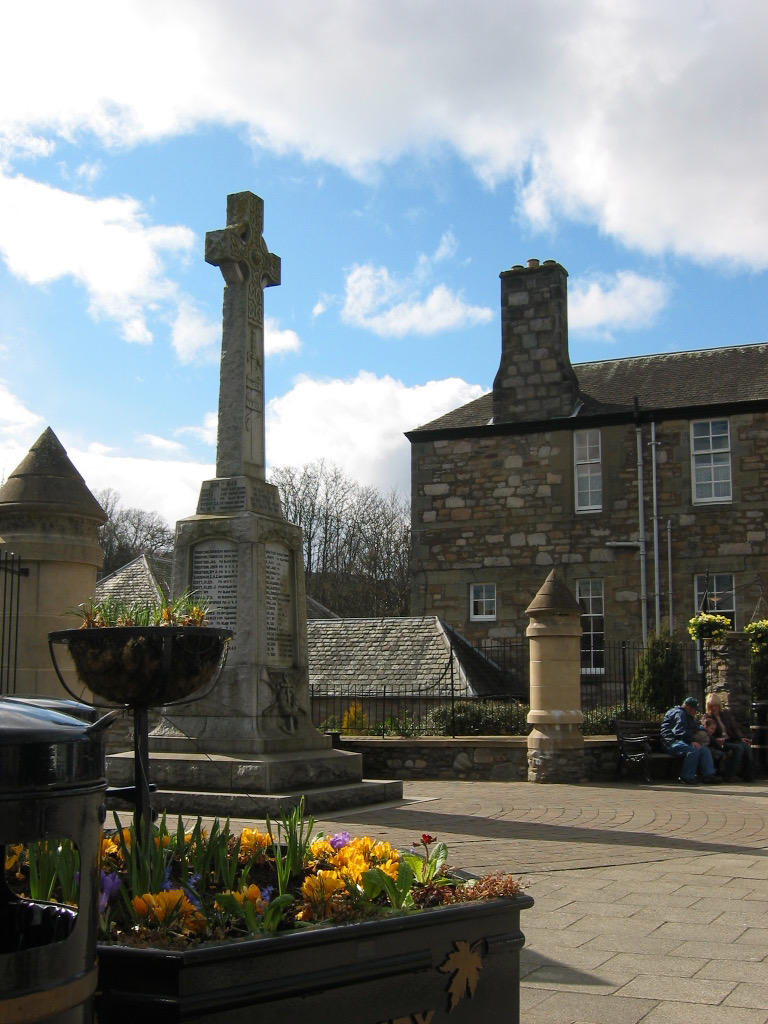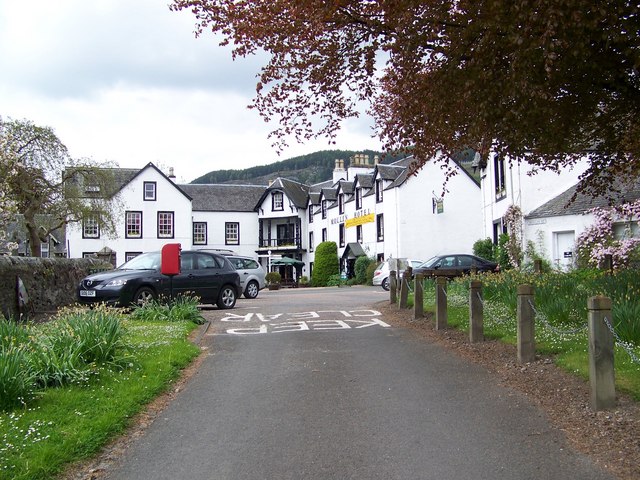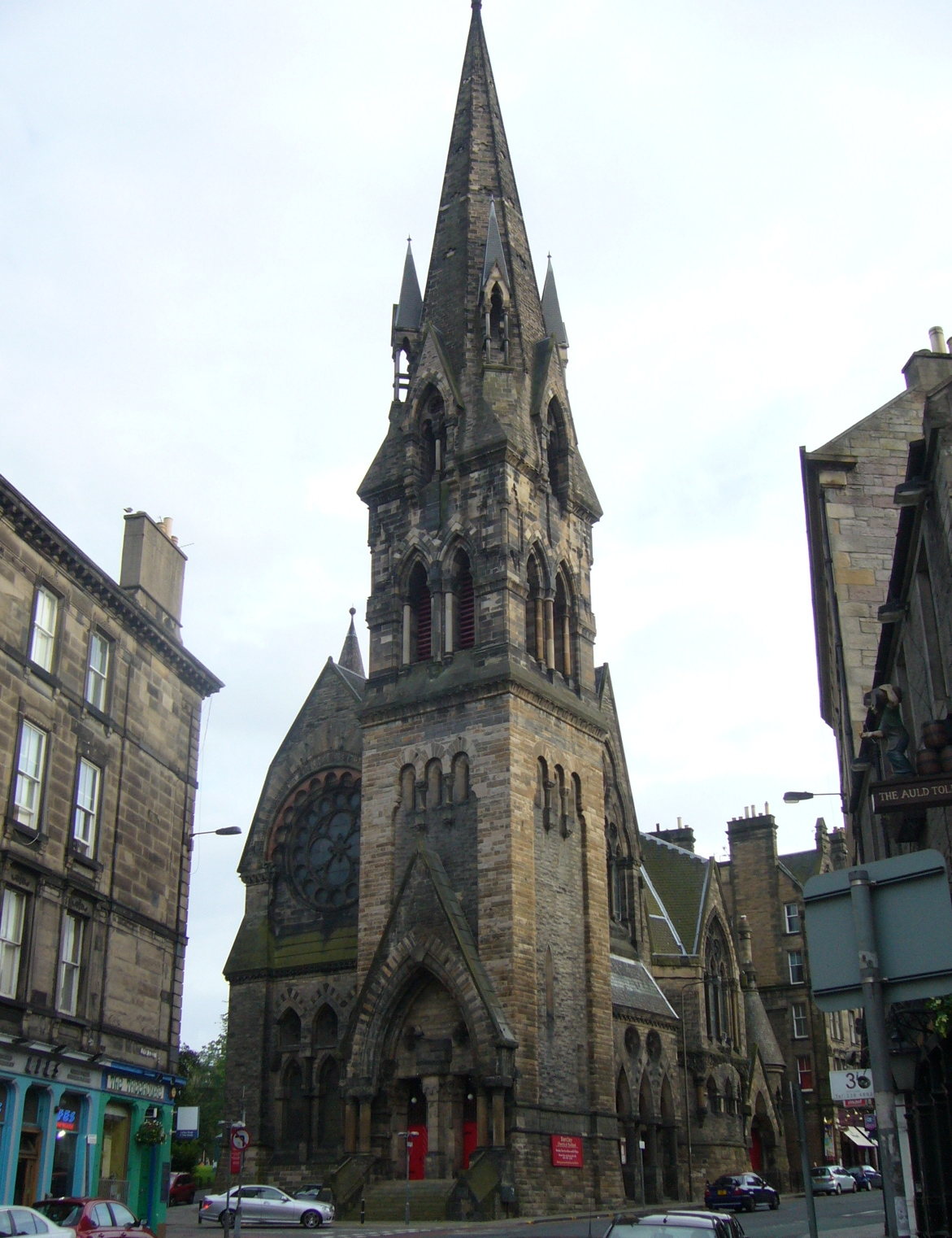|
Pitlochry Church Of Scotland
Pitlochry Church of Scotland is a congregation of the Church of Scotland, a Presbyterian Church. The church building is located in Church Road, Pitlochry, in Perthshire, Scotland. The church today serves the tourist town of Pitlochry in the Tummel valley. The church is a category A listed building. History The congregation which today worships in Pitlochry can trace its history back to at least the 7th century when it seems that a church dedicated to St Colm or St Colman was founded. Further evidence of early Christian activity in the area is the Dunfallandy Stone, an 8th-century Pictish stone depicting a Celtic Christian Cross, which was found near Killiecrankie, to the north. but was moved to Dunfallandy farm close to Pitlochry. The original parish church was at Moulin, just north of Pitlochry, from the Middle Ages. A charter for the church at Moulin together with "three carucates of land" was granted to the monks of Dunfermline Abbey by William the Lion, King of the Sc ... [...More Info...] [...Related Items...] OR: [Wikipedia] [Google] [Baidu] |
Pitlochry
Pitlochry (; gd, Baile Chloichridh or ) is a town in the Perth and Kinross council area of Scotland, lying on the River Tummel. It is historically in the county of Perthshire, and has a population of 2,776, according to the 2011 census.Scotland's 2011 census. (n.p.). Scotland's Census. Retrieved 24 November 2015, from http://www.scotlandscensus.gov.uk/ It is largely a Victorian town, which developed into a tourist resort after Queen Victoria and Prince Albert visited the area in 1842 and bought a highland estate at Balmoral, and the arrival of the railway in 1863. It remains a popular tourist resort today and is particularly known for its Pitlochry Festival Theatre, salmon ladder and as a centre for hillwalking, surrounded by mountains such as Ben Vrackie and Schiehallion. It is popular as a base for coach holidays. The town has retained many stone Victorian buildings, and the high street has an unusual period cast iron canopy over one side. History Pitlochry today dat ... [...More Info...] [...Related Items...] OR: [Wikipedia] [Google] [Baidu] |
Moulin, Scotland
Moulin is a village in Perthshire in central Scotland. It lies in the Tummel valley, north of Pitlochry, and north of Perth. The Black Castle of Moulin is the ruined remains of a 14th-century castle, built on a former island. The castle was burned down in 1512. Moulin Kirk was the parish church of the area from the Middle Ages. The church was granted to the monks of Dunfermline Abbey by William the Lion, King of the Scots from 1165 to 1214. In 1873 the church was gutted by fire and the present building was constructed. In 1989 the church was closed, and the parish church is now Pitlochry Church of Scotland. Rev Adam Fergusson was minister of the parish from 1736 to 1785, serving as Moderator of the General Assembly of the Church of Scotland in 1772. Robert Louis Stevenson Robert Louis Stevenson (born Robert Lewis Balfour Stevenson; 13 November 1850 – 3 December 1894) was a Scottish novelist, essayist, poet and travel writer. He is best known for works such as ''Tr ... [...More Info...] [...Related Items...] OR: [Wikipedia] [Google] [Baidu] |
Churches In Perth And Kinross
Church may refer to: Religion * Church (building), a building for Christian religious activities * Church (congregation), a local congregation of a Christian denomination * Church service, a formalized period of Christian communal worship * Christian denomination, a Christian organization with distinct doctrine and practice * Christian Church, either the collective body of all Christian believers, or early Christianity Places United Kingdom * Church (Liverpool ward), a Liverpool City Council ward * Church (Reading ward), a Reading Borough Council ward * Church (Sefton ward), a Metropolitan Borough of Sefton ward * Church, Lancashire, England United States * Church, Iowa, an unincorporated community * Church Lake, a lake in Minnesota Arts, entertainment, and media * ''Church magazine'', a pastoral theology magazine published by the National Pastoral Life Center Fictional entities * Church (''Red vs. Blue''), a fictional character in the video web series ''Red vs. Blue'' * Churc ... [...More Info...] [...Related Items...] OR: [Wikipedia] [Google] [Baidu] |
Church Of Scotland Churches In Scotland
Church may refer to: Religion * Church (building), a building for Christian religious activities * Church (congregation), a local congregation of a Christian denomination * Church service, a formalized period of Christian communal worship * Christian denomination, a Christian organization with distinct doctrine and practice * Christian Church, either the collective body of all Christian believers, or early Christianity Places United Kingdom * Church (Liverpool ward), a Liverpool City Council ward * Church (Reading ward), a Reading Borough Council ward * Church (Sefton ward), a Metropolitan Borough of Sefton ward * Church, Lancashire, England United States * Church, Iowa, an unincorporated community * Church Lake, a lake in Minnesota Arts, entertainment, and media * '' Church magazine'', a pastoral theology magazine published by the National Pastoral Life Center Fictional entities * Church (''Red vs. Blue''), a fictional character in the video web series ''Red vs. Blue'' * Chu ... [...More Info...] [...Related Items...] OR: [Wikipedia] [Google] [Baidu] |
List Of Church Of Scotland Parishes
The Church of Scotland, the national church of Scotland, divides the country into Presbyteries, which in turn are subdivided into Parishes, each served by a parish church, usually with its own minister. Unions and readjustments may however result in a parish having more than one building, or several parishes sharing a minister. There are currently 42 presbyteries in Scotland, and around 1500 parishes. In addition, the Church of Scotland has three presbyteries outwith Scotland: the Presbytery of England, the Presbytery of Europe and the Presbytery of Jerusalem. These presbyteries have ''"gathered congregations"'' rather than parishes. What follows is a list of Church of Scotland parishes, congregations and places of worship. Use :Church of Scotland for an alphabetical index of parishes with Wikipedia articles. A complete list of parishes with statistical data will be found in the Church of Scotland Yearbook (known as ''the Red Book''). See also List of Church of Scotland synod ... [...More Info...] [...Related Items...] OR: [Wikipedia] [Google] [Baidu] |
Spiritual Formation
Spiritual formation may refer either to the process and practices by which a person may progress in one's spiritual or religious life or to a movement in Protestant Christianity that emphasizes these processes and practices. The processes may include, but are not limited to, * Specific techniques of prayer and meditation * A lifestyle integrating spiritual disciplines or exercises * Understanding and practice of historical religious philosophy and techniques *The knowledge and expression of the truth of God and of self There are numerous definitions of spiritual formation and no definitive depiction due to the breadth of the concept and the numerous perspectives from which religious persons may approach it. From a Christian standpoint, most would argue that it is identical with sanctification as understood as a progressive and gradual process of maturation. It is often referred to as "being conformed to the image of Christ," being made holy, or the formation of virtue and characte ... [...More Info...] [...Related Items...] OR: [Wikipedia] [Google] [Baidu] |
List Of Moderators Of The General Assembly Of The Church Of Scotland
List of Moderators of the General Assembly of the Church of Scotland is a complete list of Moderators of the General Assembly of the Church of Scotland from the Reformation to the present day. Some listed below also currently have their own article. The location of the parish or other post during the Moderator's year in office is also listed (in brackets). Since 1714 the General Assembly has normally been held annually every May. Moderators-designate are nominated in the October of the previous year; a formal vote is taken at start of the General Assembly (in May), then the new Moderator takes the chair. He/she holds office for one year; his/her final act is to formally open the following year's General Assembly and preside over the formal election of a successor. The Moderator of the current year (while serving their term as Moderator) is styled ''"The Right Reverend"'', while past Moderators are styled ''"The Very Reverend"''. 16th century *1562 ''(June)'' and 1568 ''(Dec)'' J ... [...More Info...] [...Related Items...] OR: [Wikipedia] [Google] [Baidu] |
Banchory Ternan East Church
Banchory Ternan East Parish Church is a congregation of the Church of Scotland, a member of the Presbyterian Church. The church building is located in Station Road, Banchory, Kincardineshire, Scotland. The church today serves the east parish of the town of Banchory in Royal Deeside. History Over 1,500 years ago, Saint Ternan brought Christianity to Banchory with the erection of a monastery. As well as preaching the Christian gospel, he and his followers taught the local people farming, arts, and crafts. In AD 1143, the Abbot of Arbroath received a grant of land from William the Lion which extended as far as Banchory. A new settlement was created near the churchyard, and a church, school, and houses were built. From that period there was a continuous Christian presence in Banchory with several churches being built in succession. One such church was opened in 1664/65; the bell from this church now hangs in the old Watchtower in the graveyard. That church was demolished and a new o ... [...More Info...] [...Related Items...] OR: [Wikipedia] [Google] [Baidu] |
United Free Church Of Scotland
The United Free Church of Scotland (UF Church; gd, An Eaglais Shaor Aonaichte, sco, The Unitit Free Kirk o Scotland) is a Scottish Presbyterian denomination formed in 1900 by the union of the United Presbyterian Church of Scotland (or UP) and the majority of the 19th-century Free Church of Scotland. The majority of the United Free Church of Scotland united with the Church of Scotland in 1929. Origins The Free Church of Scotland seceded from the Church of Scotland in the Disruption of 1843. The United Presbyterian Church was formed in 1847 by a union of the United Secession and Relief Churches, both of which had split from the Church of Scotland. The two denominations united in 1900 to form the United Free Church (except for a small section of the Free Church who rejected the union and continued independently under the name of the Free Church). Legal dispute:''The Free Church Case'' The minority of the Free Church, which had refused to join the union, quickly tested i ... [...More Info...] [...Related Items...] OR: [Wikipedia] [Google] [Baidu] |
Alexander Duff (missionary)
Alexander Duff (25 April 1806, in Edinburgh – 12 February 1878, in Sidmouth), was a Christian missionary in India; where he played a large part in the development of higher education. He was a Moderator of the General Assembly and convener of the foreign missions committee of the Free Church of Scotland and a scientific liberal reformer of anglicized evangelism across the Empire. He was the first overseas missionary of the Church of Scotland to India. On 13 July 1830 he founded the General Assembly's Institution in Calcutta, now known as the Scottish Church College. He also played a part in establishing the University of Calcutta. He was twice Moderator of the Free Church of Scotland in 1851 and 1873, the only person to serve the role twice. Early life Alexander Duff was born in the heart of Scotland, at Auchnahyle, in the parish of Moulin, Perthshire and was brought up at Balnakeilly. His parents were James Duff, gardener and farmer at Auchnahagh, and Jean Rattray. Alexand ... [...More Info...] [...Related Items...] OR: [Wikipedia] [Google] [Baidu] |
F T Pilkington
Frederick Thomas Pilkington (1832-1898), pupil of his father, was a "Rogue" British architect, practising in the Victorian High Gothic revival style. He designed mostly churches and institutional buildings in Scotland. Typical of his work is the Barclay Church in Edinburgh, a polychrome stone structure with early French Gothic details. Life Pilkington was one of several children to Thomas Pilkington, architect, and Jane Butterworth of Stamford, England. The family moved to Edinburgh in 1854. In 1855 T. Pilkington & Son, architects and surveyors, were living and working at 10 Dundas Street in Edinburgh's Second New Town. Pilkington studied mathematics under Professor Philip Kelland at the University of Edinburgh, passed his exams in 1858 and was Hamilton prizewinner in Logic, but did not bother to graduate. He signed the University Matriculation Register 1856/7 as of Stamford. Pilkington married in 1858 and lived at Mary Cottage in the suburb of Trinity in the north of Edinbu ... [...More Info...] [...Related Items...] OR: [Wikipedia] [Google] [Baidu] |
Victorian Gothic
Gothic Revival (also referred to as Victorian Gothic, neo-Gothic, or Gothick) is an architectural movement that began in the late 1740s in England. The movement gained momentum and expanded in the first half of the 19th century, as increasingly serious and learned admirers of the neo-Gothic styles sought to revive medieval Gothic architecture, intending to complement or even supersede the neoclassical styles prevalent at the time. Gothic Revival draws upon features of medieval examples, including decorative patterns, finials, lancet windows, and hood moulds. By the middle of the 19th century, Gothic had become the preeminent architectural style in the Western world, only to fall out of fashion in the 1880s and early 1890s. The Gothic Revival movement's roots are intertwined with philosophical movements associated with Catholicism and a re-awakening of high church or Anglo-Catholic belief concerned by the growth of religious nonconformism. Ultimately, the "Anglo-Catholicism" tra ... [...More Info...] [...Related Items...] OR: [Wikipedia] [Google] [Baidu] |





